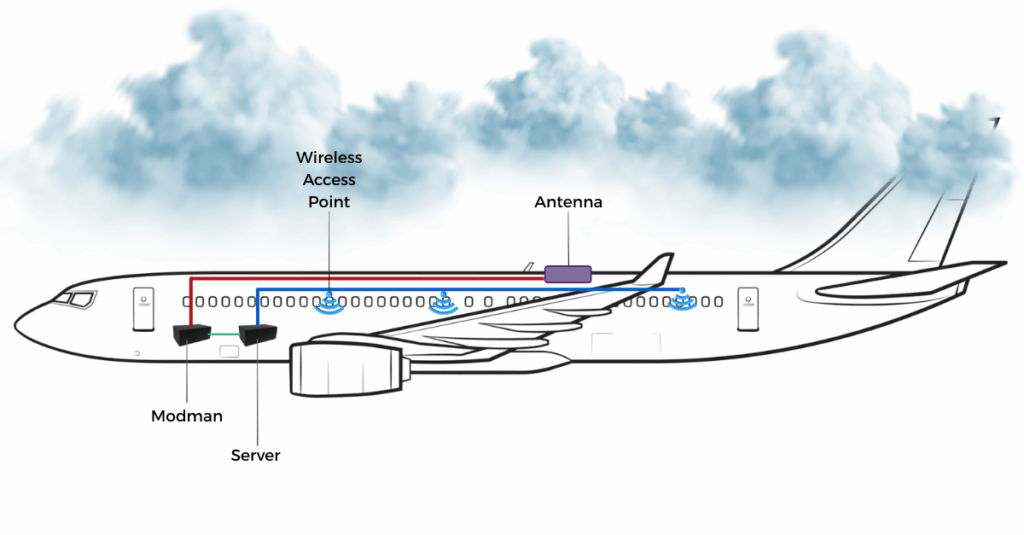


The inflight connectivity (IFC) landscape is undergoing rapid transformation. According to Aircraft Interiors International, over 11,000 commercial aircraft were equipped with IFC systems by the end of 2023, contributing to a global fleet of 38,000 connected aircraft. This surge has been fueled not only by commercial aviation, but also by substantial growth in the business and general aviation segments, which now account for nearly 68% of the connected market.
This growth is driven in part by the rise of non-geostationary satellite (NGSO) constellations—such as OneWeb, Kuiper, and Telesat Lightspeed—as well as renewed momentum behind Air-to-Ground (ATG) networks.
If your airline is planning to join this connected future, the time to lay the groundwork is now. From choosing the right onboard architecture to planning phased upgrades, here’s what you need to consider to ensure a future-ready inflight connectivity solution.
If your airline is considering implementing or upgrading its inflight connectivity services, it’s crucial to understand the essential components and strategic decisions that ensure a future-proof investment.
Bringing inflight connectivity to your aircraft requires careful integration of four major hardware components:
The antenna is the bridge between the aircraft and satellites or ground networks, making it one of the most critical components.
It is the cornerstone of satellite-based IFC. Mounted on the top of the fuselage, it communicates with satellites to provide broadband internet to the aircraft. For Air-to-Ground (ATG) solutions, the antenna is significantly smaller and placed on the aircraft belly, connecting with ground-based 5g cellular towers.
Acting as the bridge between the antenna and the onboard systems, the MODMAN converts the satellite or ATG signal into a standard IP connection. This conversion allows seamless integration with cabin systems like entertainment, e-commerce, and crew services.
Together, the Antenna + MODMAN are referred to as the IFC “Terminal.”
This onboard server is the brain of the Inflight Digital Platform, hosting services such as wireless inflight entertainment (W-IFE), onboard e-commerce, cabin crew portals, and real-time advertising. PXCom’s SkyVerse platform is designed to run efficiently on certified hardware, delivering a customizable passenger experience.
WAPs distribute Wi-Fi throughout the cabin, ensuring strong and consistent signal strength for passenger devices, smart cabin systems, and crew operations.
The Server + WAPs make up the Inflight Digital Platform.
The IFC landscape is evolving fast. While many NGSO networks are still building out global coverage, major innovations are expected to mature by 2026–2027. If your airline isn’t ready to commit to full IFC yet, you can still start preparing with future-ready infrastructure:
Request Structural Provisions for Antennas:
Even if you postpone antenna installation, don’t forget to request structural provisions for your upcoming aircraft. Without such provision, it can quickly turn into a show stopper.
Deploy a Wireless IFE Platform Today:
Launching a wireless inflight entertainment system (W-IFE) with embedded architecture (server + WAPs) provides immediate passenger value, while building the foundation for connectivity integration later.
Choose IFC-Compatible Hardware from Day One:
Selecting IFC approved hardware suppliers like Astronics, Kontron, or KID Systeme ensures that when your IFC provider is chosen, they won’t require expensive hardware replacement. Connectivity providers typically insist on specific hardware to support service-level agreements (SLAs), and using standard components avoids unnecessary retrofit costs.
At PXCom, we understand that inflight connectivity is more than just an internet pipe—it’s the digital backbone for the entire onboard experience. That’s why our SkyVerse platform is purpose-built to help airlines take a modular, future-proof approach to inflight digitization.
Whether you’re preparing for full connectivity in the coming years or deploying an immediate wireless inflight entertainment (W-IFE) solution, PXCom gives you the flexibility to adapt and grow. Our platform operates on industry-standard servers from leading manufacturers like Astronics, Kontron, and KID Systeme, ensuring seamless compatibility with the most demanding IFC providers and their SLA requirements.
Inflight connectivity is rapidly reshaping the competitive landscape of aviation. With NGSO constellations advancing, ATG networks resurging, and passenger expectations rising, the question is no longer if you should connect your fleet—but how soon.
Airlines that take the time today to strategically prepare their aircraft and onboard digital platforms will be the ones best positioned to lead tomorrow’s skies. Whether that means laying the groundwork for satellite antennas, deploying a revenue-generating W-IFE system, or selecting IFC-ready hardware, each decision builds a stronger digital foundation.
With PXCom and SkyVerse, you can confidently navigate this transformation—on your own terms, at your own pace.
TRAVELER’S MICRO-MOMENTS Home Capturing the Traveler's Micro-Moments 26 April 2022 microMoments, Technology, traveler Time Is No Longer Measured in Days,…
IFE TO THE RESCUE Home WHEN IFE COMES TO THE RESCUE OF FLIGHT ATTENDANTS! 25 June 2022 Digital Services, IFE,…
Digital AD: IVT-FREE Zone Home DIGITAL INFLIGHT ADVERTISING: AN IVT-FREE ZONE 20 May 2022 Advertising, IVTFREE, Technology In late 2015,…